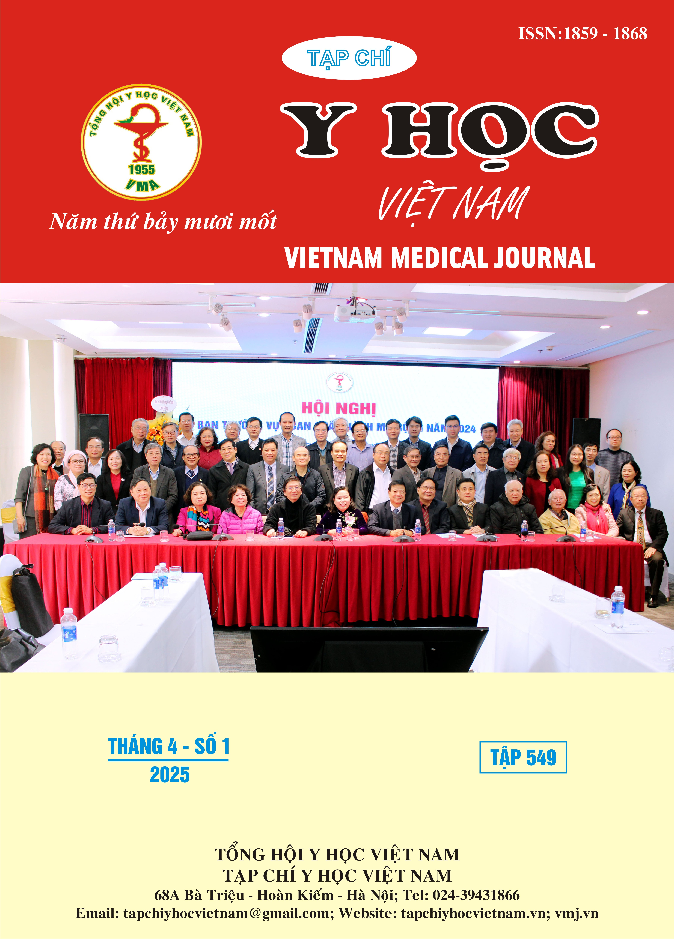MỐI LIÊN QUAN GIỮA TRIỆU CHỨNG HẠN CHẾ HÁ MIỆNG VỚI CÁC ĐẶC ĐIỂM HÌNH ẢNH CỘNG HƯỞNG TỪ KHỚP THÁI DƯƠNG HÀM Ở BỆNH NHÂN CÓ RỐI LOẠN NỘI KHỚP
Nội dung chính của bài viết
Tóm tắt
Nghiên cứu mô tả tiến cứu tại Bệnh viện Đại học Y Hà Nội từ 8/2023 đến 8/2024 trên 178 bệnh nhân với 267 khớp được chẩn đoán lâm sàng mắc hội chứng rối loạn nội khớp thái dương hàm (TDH). Tất cả các bệnh nhân được khai thác triệu chứng hạn chế há miệng và đo độ há miệng tối đa, sau đó được chụp cộng hưởng từ (CHT) khớp TDH. Các bất thường trên hình ảnh CHT của khớp sẽ được đối chiếu nhằm xác định mối liên quan giữa các đặc điểm hình ảnh với triệu chứng hạn chế há miệng. Độ tuổi trung bình của nhóm bệnh nhân là 25,8±11,5, thấp nhất 11 tuổi, cao nhất 68 tuổi. Có mối liên quan giữa triệu chứng hạn chế há miệng với bất thường vị trí đĩa khớp (p<0,01), với các biến đổi hình dạng đĩa khớp (p=0,015), hình dạng lồi cầu (p=0,01) trên hình ảnh CHT.
Chi tiết bài viết
Từ khóa
Rối loạn nội khớp thái dương hàm, cộng hưởng từ, hạn chế há miệng
Tài liệu tham khảo
2. Paesani D, Westesson P-L, Hatala M, Tallents RH, Kurita K. Prevalence of temporomandibular joint internal derangement in patients with craniomandibular disorders. American Journal of Orthodontics and Dentofacial Orthopedics. 1992;101(1):41-47.
3. Taşkaya-Yýlmaz N, Öğütcen-Toller M. Clinical correlation of MRI findings of internal derangements of the temporomandibular joints. British Journal of Oral and Maxillofacial Surgery. 2002;40(4):317-321.
4. Li C, Chen B, Zhang R, Zhang Q. Comparative study of clinical and MRI features of TMD patients with or without joint effusion: a retrospective study. BMC Oral Health. 2024;24(1):314.
5. Rammelsberg P, Pospiech PR, Jäger L, Duc J-MP, Böhm AO, Gernet W. Variability of disk position in asymptomatic volunteers and patients with internal derangements of the TMJ. Oral Surgery, Oral Medicine, Oral Pathology, Oral Radiology, and Endodontology. 1997;83(3):393-399.
6. Murakami S, Takahashi A, Nishiyama H, Fujishita M, Fuchihata H. Magnetic resonance evaluation of the temporomandibular joint disc position and configuration. Dentomaxillofacial Radiology. 1993;22(4):205-207.
7. Ege B, Kucuk AO, Koparal M, Koyuncu I, Gonel A. Evaluation of serum prolidase activity and oxidative stress in patients with temporomandibular joint internal derangement. CRANIO®. 2019;
8. Müller‐Leisse C, Augthun M, Bauer W, Roth A, Günther R. Anterior disc displacement without reduction in the temporomandibular joint: MRI and associated clinical findings. Journal of Magnetic Resonance Imaging. 1996;6(5):769-774.
9. Kumar R, Pallagatti S, Sheikh S, Mittal A, Gupta D, Gupta S. Suppl 2: M4: Correlation Between Clinical Findings of Temporomandibular Disorders and MRI Characteristics of Disc Displacement. The open dentistry journal. 2015;9:273.
10. Maizlin ZV, Nutiu N, Dent PB, et al. Displacement of the temporomandibular joint disk: correlation between clinical findings and MRI characteristics. Journal (Canadian Dental Association). 2010;76:a3-a3.


